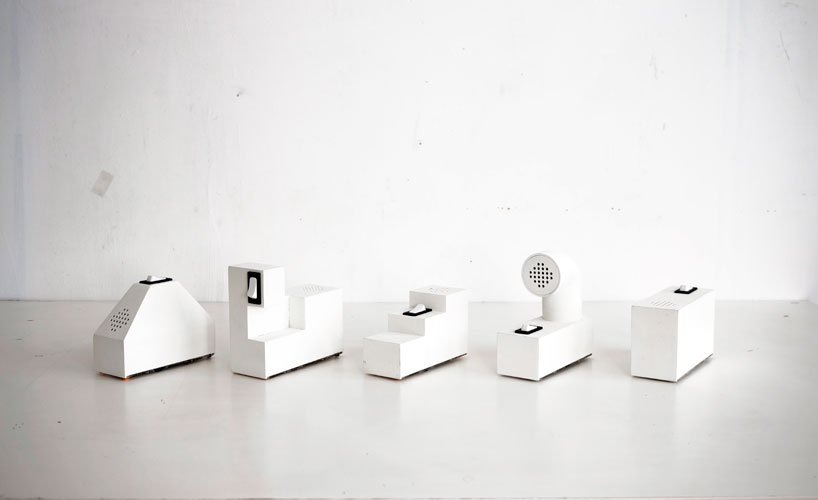
Yuri Suzuki: Looks Like Music
Description
Yuri Suzuki was invited by Mudam’s Public Department to create an audiovisual installation; “Looks Like Music”. This was an attempt to visualize sound. This installation was based on his work Color Chasers.
In this installation, the public is invited to create a circuit by drawing a black line with a marker. This black line is interspersed with colored reference points that the Color Chaser will pick up and translate into noise.
As a result, not only does the audience get the opportunity to participate in creating a large scale artwork but they also create a collectively composed music piece.
 ↑ Color Chasers
↑ Color Chasers
Each Color Chaser emits a different noise ranging from drum, electronic noise, bass, melodies, and arpeggio sounds. The form of each robot is a variation of a white box shape. Each adjustment intends to deliver the different noises each Color Chaser emits. Thus, visualization of sound is achieved not only through the noises a Color Chaser emits as it follows a line drawn by the audience but also through the various forms the Color Chaser takes to represent the noise it emits.

Suzuki explains his intentions behind the robot as, “The drum robot has a triangular body to represent the sound wave of a drum and the electronic piece has a computer-like grid shape.” and “There is a physical presence to express the content to help people imagine the sound of music.”
Relevant Concepts | Readings | Artworks
One of the relevant concepts from our History of Design course regarding “Looks Like Music” is interactivity.
The art work cannot exist without the participation of the audience and the artist cannot foresee or control how the art piece will be shaped. In other words, it thrives on interactivity.
In addition, it can be said that “Looks Like Music” is behavioral art because its outcomes are not fixed. The wide scale circuit as well as the harmony of sounds created by the Color Chasers moving along the lines can always change depending on the actions of the viewer. It also requires the input of a viewer and is responsive to it.
One question I have is whether this art work can be considered as “Cybernated Art”. Cybernated Art is when the art piece embraces the technologies of an information society such as a television.
While the Color Chasers are not a norm of information technology, in some ways it could be considered a new form of information technology. This is because it visualizes music and in a way helps inform the user. In addition, Suzuki’s intention has to be considered. From the quote, “I’m dyslexic and am very interested in what is needed for people to understand music. The black line explains the length of the song and then the color is directly translated into sound. It’s a very simple method to express music,” we can learn the Suzuki intended to create a new form of technology that helps dyslexic people understand music. In a sense this means Color Chasers could be considered a new type of information technology and in turn perhaps Cybernated Art.
One relevant artwork I was reminded of when I first learnt about “Looks Like Music” is “Soundings (1968)” by Robert Rasuchenberg that was introduced to us in the course. In this piece, the different vocal sounds of the viewers would emit a different set of lights.
I found it similar to Suzuki’s work because both allows the audience to be active participant in forming the art piece as well as creating musical harmony. The audience are not passive recipients of the art work.
Reference
http://yurisuzuki.com/artist/looks-like-music
https://www.disegnodaily.com/article/looks-like-music-by-yuri-suzuki
https://www.designboom.com/technology/yuri-suzuki-looks-like-music-audiovisual-installation-at-mudam/
https://oss.adm.ntu.edu.sg/18s1-dd3016-tut-g03/syllabus/im-lesson-1-interactivity/
